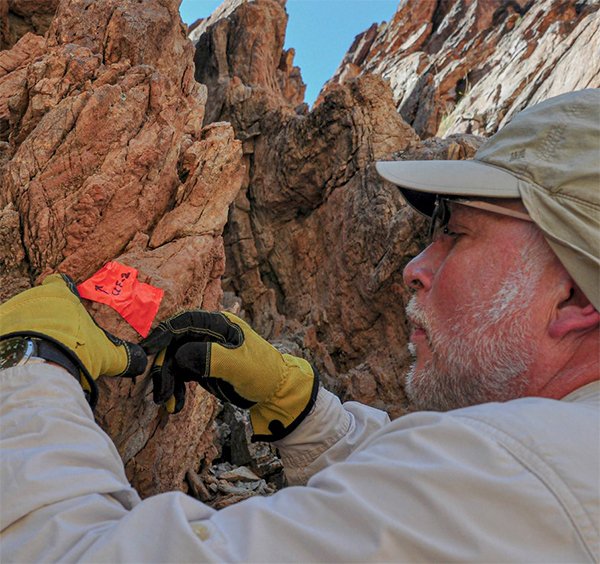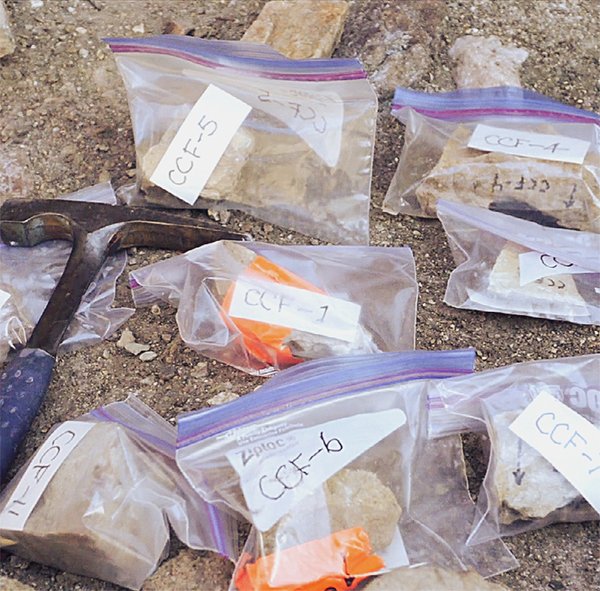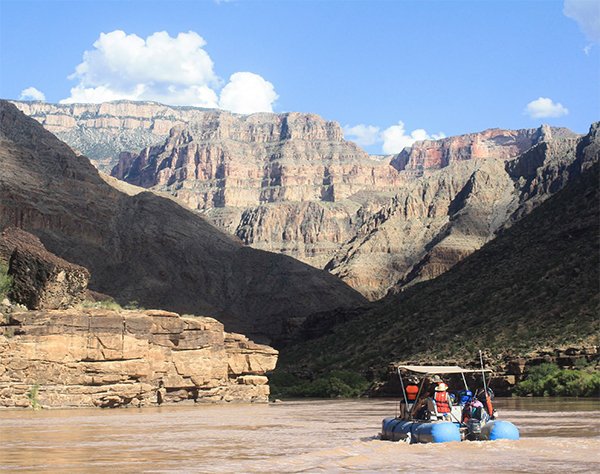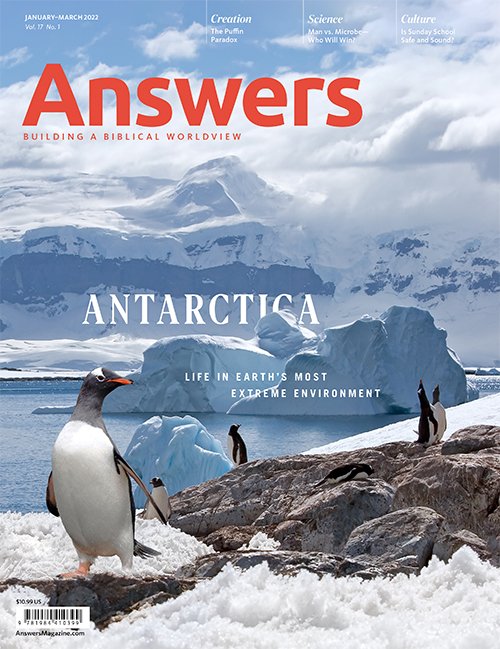The Fight for 53 Rocks
Searching for evidence of the global flood led Dr. Andrew Snelling into the Grand Canyon—and sparked the fight of his career.
Grand Canyon is hard to comprehend. It stretches some 277 miles through northern Arizona, reaches a depth of over a mile, and spans up to 18 miles wide. This gargantuan gash in the earth is even visible from the moon.
No one is ever fully prepared to see Grand Canyon for the first time. Usually the person lets out an audible gasp, stunned by the unexpected magnitude and beauty of the enormous chasm.
I remember the first time I saw the canyon in April 1990. I was awed by the spectacle and overwhelmed by its magnitude. Since that first encounter, I have hiked in the canyon several times and rafted down the Colorado River through the canyon more than 40 times. The wilderness isolation and towering cliffs are humbling. I never tire of showing people the incredible thicknesses and extent of the fossil-bearing layers in the canyon’s walls that could only have been deposited by the global Genesis flood.
Yet back in 1990, as I embarked on my search for evidence that confirmed the cataclysmic global flood, I couldn’t have known that Grand Canyon would eventually be the site of the biggest battle of my career—suing Grand Canyon National Park and the National Park Service for 53 small samples of rock.

Photo by Dr. Andrew A. Snelling
The Canyon Quandary
Grand Canyon is a geologist’s playground, offering a one-of-a-kind scope of exposed geologic details to study. Its strata (layers) span the full range of earth history, from the continent’s crystalline foundation rocks, through several upheavals that tilted and shaped earlier strata, to the present landscape. All the geology textbooks extoll the canyon as a supreme example of the supposed millions of years of slow geologic processes that presumably deposited the layers and then slowly carved the canyon into those layers.
The quest to explain the myriad geologic details within Grand Canyon is never ending. But that doesn’t stop geologists from deriving explanations according to their beliefs about the past. Our conclusions can never be final, however, because no geologists were there to observe the rocks forming or the canyon being carved.
Evolutionists puzzle over how and when the plateau, through which the canyon was carved, was uplifted. At the plateau’s eastern edge, all the horizontal sedimentary rock layers have been bent (folded), dramatically in some places. The enigma is that the layers have been bent smoothly. But when it’s bent, solid rock should shatter. So how were these layers folded?
Tale of the Tapeats
Evolutionary geologists insist that one of the earliest of these fossil-bearing sedimentary layers, the Tapeats Sandstone, was deposited 507–508 million years ago. Over the next 450 million years, the sandstone was compressed and hardened as more than 10,000 feet of other sediment layers were deposited on top of it. Then 50–60 million years ago these layers were bent as the plateau was pushed up, along with the Rocky Mountains as the tectonic plates shifted. Their view requires that the hardened sandstone was made flexible like playdough by the pressure and heat of the deep burial and the subsequent earth movements so it would bend smoothly. This pressure and heat should have metamorphosed the original sedimentary rock layers, changing the minerals, their crystal shapes, and the rock textures.
On the other hand, flood geologists would argue that the Tapeats Sandstone was laid down in the first month of the biblical global flood cataclysm, only about 4,350 years ago. The more than 10,000 feet of other sedimentary layers were then deposited through the rest of the flood year. All these layers would have still been wet and relatively soft after about a year under the flood waters when they were then uplifted to form the plateau. In this short time, the layers bent smoothly without shattering and only subsequently dried out and hardened.1 If this is the case, we should see no metamorphic changes in the rocks.
Did the layers bend after the sand was deposited and then hardened all over more than 500 million years? Or did the layers bend less than a year after the sand was deposited and then harden during and soon after the yearlong global flood cataclysm only about 4,350 years ago? Each possibility has far-reaching implications regarding our view of earth history. Which possibility matches the data we observe in the rocks themselves?
For the answer, we would have to examine the Tapeats Sandstone under a geological microscope to see what minerals it contains and examine the cement binding the grains to determine if any metamorphic changes have occurred.
Over 20 years ago, I began searching the geologic literature. I was utterly surprised to find that nowhere in the voluminous geologic literature covering 150 years of research in the Grand Canyon is there a report of any such study. In fact, the only microscope photograph of the Tapeats Sandstone was a black and white image in a 1945 monograph. Without any previous research to study for answers, I determined to do the necessary investigation myself.
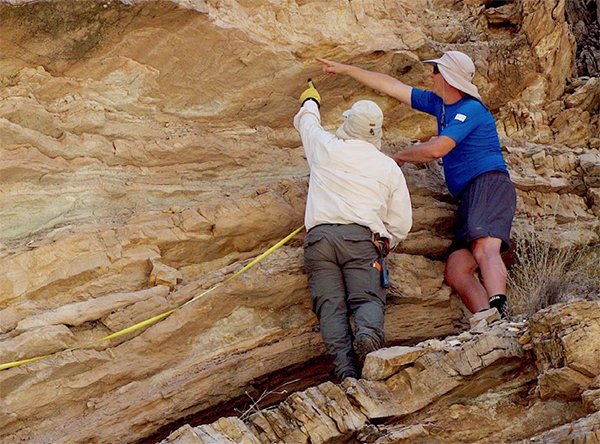
Photo by Dr. Andrew A. Snelling
Dr. Snelling (right) and Dr. Whitmore (left) examined the Tapeats Sandstone to discover the true history behind the folds.
The Battle Begins
I couldn’t just walk into Grand Canyon and start chipping away at the rocks. So on November 25, 2013, I lodged a research proposal with a research and sampling permit application with Grand Canyon National Park (GCNP) to collect 50–60 fist-size samples in four folds and of the same rock layers from locations far away from those folds for comparison. On February 9, 2014, at the request of the GCNP staff, I submitted three peer reviews supporting the research proposal.
Nearly a month later, I received a letter from the then-chief of the GCNP research office stating that my application package had been reviewed by multiple reviewers who had concluded that my study would not be permitted. They provided no technical or scientific objections to my proposed research.
Given the GCNP’s previous discrimination against creationists, Alliance Defending Freedom (ADF) lawyers got involved. They sent a Freedom of Information Act request to the National Park Service regional office in Denver for copies of all correspondence between GCNP staff pertaining to my research application.
All three had expressed scorn at my Christian faith and creationist worldview, insisting that my research not be permitted.
This request netted the comments by the three academic geologists who had reviewed my research application. All three had expressed scorn at my Christian faith and creationist worldview, insisting that my research not be permitted. Only one provided some trivial technical oversights in my research proposal.
After revising the research proposal to deal with those technical details, I resubmitted the amended research proposal with another application for a research and sampling permit. This time they insisted that, for my application to be considered, I first had to submit details and photographs of all planned sample sites.

Photo by Dr. Andrew A. Snelling
The Carbon Canyon fold in the Tapeats Sandstone
The ADF lawyers submitted another Freedom of Information request for copies of all research permits issued in early 2016. These permits revealed that GCNP had never made such requirements of any other scientists. In December of 2016, ADF sent a formal complaint letter with full documentation of the repeated discrimination to the GCNP superintendent demanding the issue be resolved.
Several months later, the GCNP superintendent finally replied, admitting my proposal was “well-stated with methods that are similar or equal to standard scientific practice to test the hypothesis provided.” Yet she repeated the demand for me to determine the sites where I planned to take rock samples, citing concerns for the environment that had never been raised with other research applications.
In May of 2017, ADF lawyers filed a lawsuit in the US District Court in Phoenix on my behalf against the GCNP, the NPS, and the Department of the Interior for worldview discrimination. All the incriminating correspondence was appended to the lawsuit.
News of the legal action appeared on the front page of the Washington Times and in the New York Times. And it wasn’t long before lawyers representing the Departments of Justice and the Interior responded to the lawsuit. After all, I was suing the federal government for worldview discrimination because this was contrary to my rights regarding the free exercise of religious beliefs, as established in Amendment One to the US Constitution. In ensuing discussions, the US government lawyers readily admitted it was an open-and-shut case and quickly sought to settle it.
On June 7, 2017, I reapplied for the research and sampling permit with GCNP, and on June 23, 2017, they issued my permit. On the same day, I also submitted a research river trip application which they granted on June 26, 2017. Two days later, on June 28, 2017, the lawsuit was deemed settled and voluntarily dismissed.
That same day, a press release announcing the lawsuit victory instigated a media flurry. Articles appeared in newspapers across the country. Reports even made it to the front page of Australia’s only national newspaper, The Australian, complete with a photo of me in Grand Canyon.
The lawsuit also showed up in the science media—the US’ premier weekly journal Science and in the newsletter of the American Association of Petroleum Geologists. In both instances, scathing comments about my academic credentials were repeated by leading academics, including one whose opposition to my research proposal was appended to the lawsuit.
Why this long struggle? Why would these academics so vehemently oppose GCNP permitting me to collect a couple dozen small samples of rocks? The simple answer is that, if these now hardened rock layers were bent in these folds while the sedimentary layers were still wet and soft soon after deposition, as expected in the biblical flood model, then the 500+ million years of evolutionary time on which they base their worldview never happened. But next, I would have to venture into the canyon to collect the rock samples necessary for me to find the evidence.
Collecting the Samples
At long last, on August 6, 2017, we launched into Grand Canyon on two 22-foot-long motorized rafts to go and collect the samples needed for the research project. My six-person support crew included Cedarville University geology professor Dr. John Whitmore. We even carried a 28-foot extension ladder to scale cliffs and more easily reach samples. Over the ensuing week, during the 280-mile Colorado River trip, we collected 53 samples: 44 from four folds and nine from the same three rock layers miles away from where they are bent in those folds.
Climbing the Folds

Photos by Dr. Andrew A. Snelling and Dr. John Whitmore
Climbing the cliff face at the Carbon Canyon fold can be treacherous.
We collected most samples from the cliff-forming Tapeats Sandstone, the bottom-most of the horizontal sedimentary layers exposed in Grand Canyon’s walls. Flood geologists, including myself, maintain that it was one of the first sediment layers deposited at the outset of the global flood. It sits on an erosion surface produced by the devastating watery destruction of the pre-flood land surface. The Tapeats Sandstone and that erosion surface, known as the Great Unconformity, can be traced right across North America to other continents and even globally.2 Our first major stop was at Carbon Canyon, a side-canyon 65 miles downstream of our launch ramp. It required a 1.5-mile hike clambering over large boulders and climbing crude stone stairs up a ~200-feet scree slope to reach the Carbon Canyon fold, in which the Tapeats Sandstone is spectacularly bent smoothly at 90º.
Fortunately, ledges between the beds within the sandstone enabled us to climb up the cliff onto the fold to select two target beds, collect samples, and make measurements. These samples came from the hinge zones (where the most bending occurred) and along the limbs of these folded beds. It was hot work under the blazing sun with high humidity.
With 12 samples loaded into our backpacks, we headed back toward the river and our rafts. But as we started down the scree slope, a rock gave way under my feet, and I tumbled down four to six feet, landing heavily on the rocks below and hitting my forehead, right elbow, and right knee.
After a few anxious moments, I was able to move, blood streaming everywhere. Patched up and hobbling, I was assisted back down to the rafts, and that evening at camp my wounds were cleaned and bandaged. At least I had brought a “spare” geologist with us to assist with the sampling work through the rest of the trip.
Painstaking Research
Safely home, the next step was to dispatch the 53 samples to the Calgary Rock and Materials Services, Inc., laboratory in Alberta, Canada. There, our creationist colleague Ray Strom followed standard procedures with observable and repeatable tests. First, he cut small pieces off each sample, crushed them, and put them in an X-ray diffractometer. In a diffractometer, X-rays that pass though the grains’ crystals scatter (diffract) according to the various minerals. Through this process, we determined both the mineral content of each sample and the amounts of those minerals.
Then, from each sample, Ray cut thin rock slices that he glued to glass microscope slides and ground down until those slices were so paper thin that light could pass through them. These thin sections were sent back for me to examine under a geological microscope to identify the mineral grains, their shapes, and the rock textures.
I spent 2,500–3,000 hours systematically examining each thin section, recording details in writing and in photographs via a camera mounted on the microscope, and checking the details against the X-ray diffraction results. In visits to the Calgary lab and the geology lab at Cedarville University, I also used geological research microscopes to obtain high quality images of selected minerals and textures for publication.
Alongside this intensive effort, I meticulously researched the extensive literature, obtaining copies of every paper, abstract, book chapter, or report written about these rock units and published in numerous US states, as well as in Britain, Europe, and Australia. We even borrowed two unpublished master’s theses from an Arizona university library.
Finally, after three years, it was time to collate all this information and write the first papers to present the research results. I plan to report all the details in papers on each of the three rock units. Subsequent papers on each of the four folds will refer to the details of the rock units in the already published papers.
The first 96-page paper on the Tapeats Sandstone was meticulously peer-reviewed before being published in the Answers Research Journal on June 23, 2021, with 55 pages of appendices.3 Similar comprehensive papers on the Bright Angel and Muav Formations have also been peer reviewed and published in the Answers Research Journal.4
The focus is now on writing and publishing the detailed papers on each of the four folds. I will also include the scanning electron microscope (SEM) images of the cement crystals between the sediment grains. Those images are necessary to close every possible loophole evolutionary geologists might use against this research.
Not surprisingly, so far as I am aware, there have been few comments from evolutionists, but it’s still early. Most comments have been aimed at my scientific credibility rather than engaging the research results accurately. Perhaps their derogatory comments will increase in volume once the remaining four papers are published this year and the results of this research appear in future programs on Answers TV.
What Does the Research Reveal?
None of the evidence supports the evolutionary idea that the folding occurred 450 million years after the sandstone was cemented. Instead, it is overwhelmingly consistent with the sand layers being deposited rapidly at the beginning of the global flood cataclysm year. The bending of the still wet, soft layers occurred only months later at the end of the flood year when the plateau was uplifted. The sand layers cemented to sandstone as they dried out at the end of and after the flood. Furthermore, no evidence points to any metamorphic changes in the sandstone or its mineral grains, either in the folds or in the samples miles away from the folds.
After a four-year battle with GCNP and the NPS, and nearly five more years of painstaking research, was it worth the fight for 53 samples? Absolutely! This research has convincingly confirmed that Grand Canyon’s layers were deposited violently during the yearlong global flood cataclysm only about 4,350 years ago and demonstrates the short time between when the Tapeats was deposited and folded—eliminating the possibility of hundreds of millions of years within the layers.
When I raft through Grand Canyon now, I feel satisfaction in a mission accomplished for the glory of our Creator and Redeemer alone.
When I raft through Grand Canyon now, I feel satisfaction in a mission accomplished for the glory of our Creator and Redeemer alone.
Flood geology research may be painstaking, but the dividends provide a powerful apologetic to defend the truth of God’s Word. And far more importantly, the findings remove stumbling blocks to the presentation of the everlasting gospel to those, who, like Noah’s wicked compatriots, need rescuing from the next global judgment that is soon coming—this time by fire.
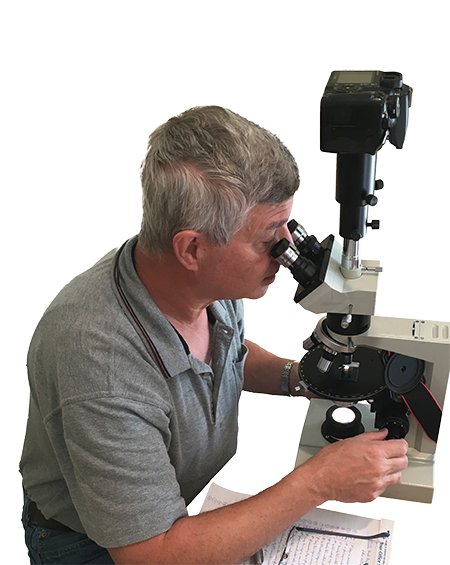
Dr. Snelling spent thousands of hours inspecting rock samples through a microscope and recording the details he observed.
What I saw in Grand Canyon’s outcrops and through the geological microscope confirmed the biblical account. The evidence pointed to the sand layers being deposited rapidly at the beginning of the global flood and bent when they were still wet and soft at the end of the flood year.
So what evidence did I see?
- Boulders at the base of the Tapeats Sandstone were transported by rapid hurricane- and/or tsunami-driven water currents.
- The layering within the Tapeats Sandstone indicates that the sand was rapidly transported and deposited by hurricane- and/or tsunami-driven water flows.
- The fossilized tracks in the layers were left behind by trilobites, worms, and other invertebrates that had scurried across or hurriedly burrowed into sand surfaces. To be preserved, those delicate traces had to be buried rapidly.
- The sandstone consists of different-sized grains mixed randomly, indicating that they were rapidly transported and deposited with no time for the grains to be sorted.
- Many of the grains of quartz (natural glass) and even the softer pink K-feldspar are not very rounded, also indicating that there was no time for the grains to be completely rounded during their transport.
- The K-feldspar grains were eroded from the nearby underlying granites, indicating that the sediment was transported only a short distance.
- The sandstone contains abundant silvery muscovite (mica) flakes. Muscovite is a soft, fragile mineral, and these flakes consist of stacked thin sheets like the pages in a book. The edge-on flakes are wedged between quartz and K-feldspar grains, usually aligned approximately parallel to the rock’s layering (which is how moving water deposits such flat flakes). Sometimes the flakes have split ends where the thin sheets have been frayed and are even bent and/or broken. These observations mean they were detrital grains (bits broken off other rock) in the sandy sediment that was rapidly transported only a short distance and deposited rapidly before the soft flakes could be completely destroyed.
- The cement binding the grains together is primarily quartz (silica). It is always intact, not having been disturbed or shattered since it grew around the detrital quartz grains and cemented them together to form the hard sandstone soon after the flood.
- Sometimes the rock fabric is a solid mass of tightly interlocking quartz with the cement indistinguishable from the grains. If the rock had been bent after the cement set, these masses of cemented quartz grains would show signs of having been shattered or broken, then recemented, but I found no such evidence.
- Neither the sandstone nor its constituent mineral grains, either in samples from the folds or in samples from miles away, showed signs of metamorphic change.
Answers Magazine
January–March 2022
God created the world to be inhabited, right down to the frozen continent at the bottom of the globe.
Browse Issue SubscribeFootnotes
- Andrew A. Snelling, “Rock Layers Folded Not Fractured,” Answers 4, no. 2 (2009): 80–83; Andrew A. Snelling, “Global Evidences of the Genesis Flood,” Answers 16, no. 3 (2021): 44–52.
- Andrew A. Snelling, “Transcontinental Rock Layers,” Answers 3, no. 3 (2008): 80–83; Andrew A. Snelling, “Global Evidences of the Genesis Flood,” Answers 16, no. 3 (2021): 44–52.
- Andrew A. Snelling, “The Petrology of the Tapeats Sandstone, Tonto Group, Grand Canyon, Arizona,” Answers Research Journal 14 (2021): 159–254.
- Andrew A. Snelling, “The Petrology of the Bright Angel Formation, Tonto Group, Grand Canyon, Arizona,” Answers Research Journal 14 (2021): 303–415; Andrew A. Snelling, “The Petrology of the Muav Formation, Tonto Group, Grand Canyon, Arizona,” Answers Research Journal 15 (2022, in press).
Recommended Resources

Answers in Genesis is an apologetics ministry, dedicated to helping Christians defend their faith and proclaim the good news of Jesus Christ.
- Customer Service 800.778.3390
- © 2024 Answers in Genesis



